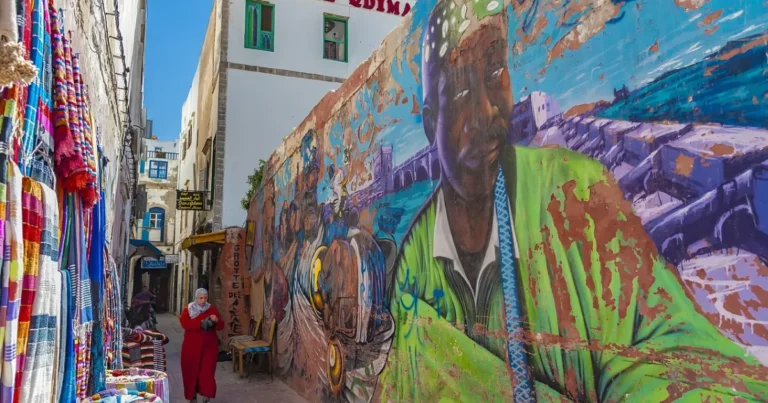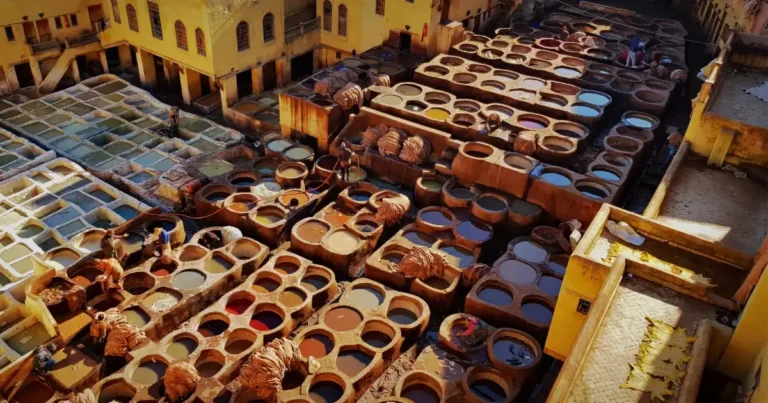Best Guide to Shopping the Souks of Marrakech Like a Local (2025)
Shopping the Souks of Marrakech, The moment you step into Marrakech’s labyrinthine souks, your senses come alive. The air fills with a heady mix of spices, leather, and perfume while the vibrant kaleidoscope of handcrafted goods stretches in every direction. Metalworkers hammer intricate patterns into lanterns, creating a musical backdrop to the animated haggling between shopkeepers and visitors. This sensory overload is precisely what makes shopping in the souks of Marrakech such an unforgettable experience.
Yet for many travelers, the prospect of navigating these bustling marketplaces can feel daunting. Getting lost among the winding alleyways, negotiating prices in an unfamiliar culture, and distinguishing quality merchandise from tourist trinkets can challenge even seasoned visitors.
Fear not! This comprehensive shopping guide to the souks of Marrakech provides everything you need for a confident, successful, and enjoyable adventure through one of the world’s most fascinating marketplaces. From detailed navigation tips and quality assessment guides to cultural etiquette and bargaining strategies, consider this your ultimate companion for treasure hunting in Marrakech’s legendary souks.
Understanding the Labyrinth: What are the Marrakech Souks?
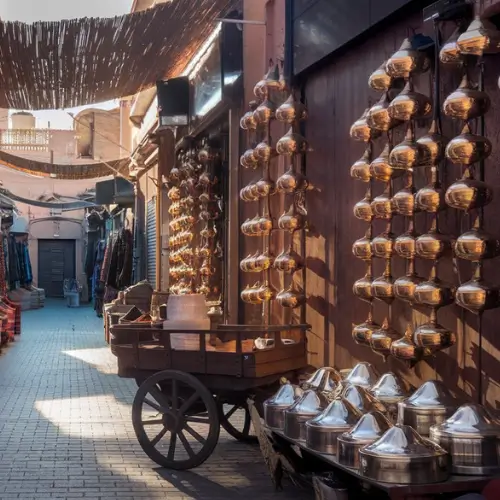
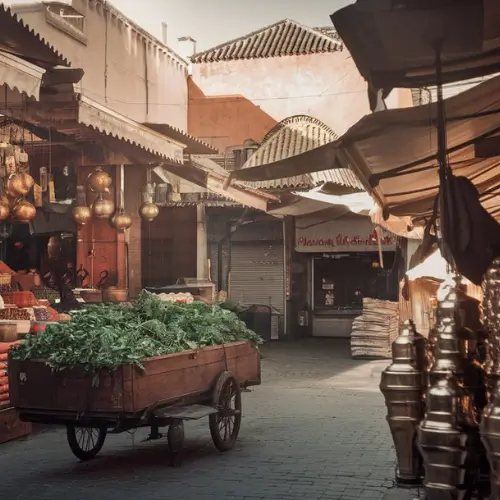
Dating back nearly a thousand years, the souks of Marrakech have served as the commercial heart of the city since the Almoravid dynasty founded it in 1070. These traditional markets evolved from caravanserai roadside inns where traveling merchants would rest and trade goods carried along ancient trade routes.
Today’s souks comprise an interconnected network of covered alleyways stretching north from the famous Djemaa el-Fna square. What appears chaotic at first glance actually follows a loose organizational logic: historically, different craft guilds clustered in specific areas, creating specialized sections for everything from spices to leather goods, textiles to metalwork.
The distinction between wholesale/artisan areas (where goods are actually produced) and retail zones (where they’re primarily sold) still exists, though less rigidly than in previous centuries. Watching artisans at work remains one of the true highlights of exploring the Marrakech souks.
Map Your Adventure: Navigating the Key Souk Areas
Souk Semmarine
As the main arterial pathway leading from Djemaa el-Fna, Souk Semmarine serves as the perfect introduction to the market experience. Here you’ll find a broad selection of goods including textiles, pottery, and traditional souvenirs. The shops here typically cater more to tourists, but the quality can still be excellent if you know what to look for. This bustling thoroughfare is wider than many other souks, making it easier to navigate for first-timers.
Souk el-Attarine
The “perfume sellers’ souk” delights the senses with pyramids of colorful spices, handcrafted soaps, and aromatic oils. The air here is perfumed with exotic scents cinnamon, saffron, rose, and amber. Beyond spices and perfumes, this area also houses many beautiful lantern shops where intricate metalwork creates mesmerizing light patterns. Visit in late afternoon when sunlight streams through the slatted roof, creating dramatic spotlights on the merchandise.
Souk Haddadine
The blacksmiths’ quarter rings with the sound of hammers shaping metal into everything from ornate candleholders to practical kitchen implements. More industrial than some other sections, this area offers fascinating glimpses into traditional metalworking techniques passed down through generations. The items here often feature less ornamentation but higher craftsmanship and durability.
Souk Cherifia
For a slightly different shopping experience, head to this multi-level complex housing boutique-style shops with more contemporary takes on traditional crafts. Here you’ll find fixed prices (a relief for those tired of haggling) and designer collaborations with local artisans. The rooftop offers excellent photo opportunities and sometimes houses pop-up exhibitions featuring modern Moroccan artists.
Souk des Teinturiers
The dyers’ souk ranks among the most photogenic spots in Marrakech. Visit in the morning to witness colorful yarns and fabrics hanging to dry after being dipped in giant vats of natural dyes. The cobalt blue section is particularly striking against the terracotta walls. This working area offers authentic glimpses into traditional textile production techniques still used today.
Navigation Tips:
- Use major landmarks rather than detailed maps the minaret of the Koutoubia Mosque remains visible from many points and can help orient you.
- GPS services work inconsistently under the covered market areas, so don’t rely exclusively on your phone.
- If truly lost, follow any pathway downhill most eventually lead back to Djemaa el-Fna.
- Ask shopkeepers (particularly those from whom you’ve purchased something) for directions rather than self-appointed guides who expect payment.
- Embrace getting a little lost some of the best discoveries happen when you wander off the main paths.
The Treasure Hunt: What to Buy in the Souks (and How to Judge Quality)
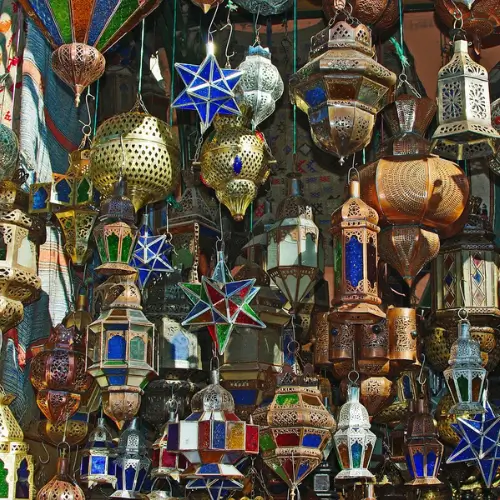
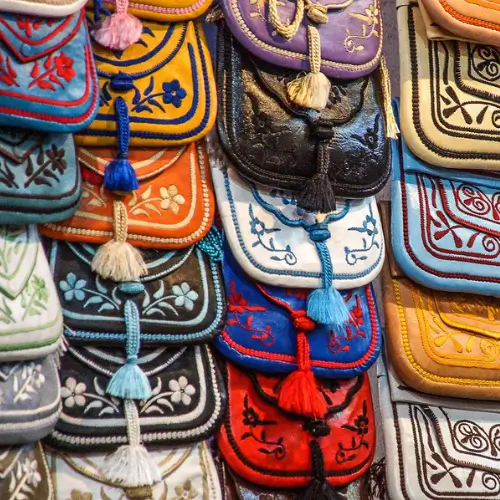
Leather Goods (Bags, Poufs, Babouches)
Morocco’s leather craftsmanship dates back centuries, with Marrakech offering everything from butter-soft handbags to colorful pointy-toed slippers (babouches) and decorative poufs.
Quality Checks:
- Smell the leather—good quality has a natural aroma without overwhelming chemical scents
- Examine stitching for evenness and reinforcement at stress points
- Check dye consistency and color-fastness (rub with a white cloth—minimal transfer is normal, excessive indicates poor quality)
- For poufs, verify they’re properly stuffed with cotton or fabric scraps, not plastic
Price Range: 200-800 MAD for babouches, 400-2000 MAD for quality bags, 300-1200 MAD for poufs (unstuffed)
Lanterns & Metalwork
Moroccan lanterns transform any space with their intricate patterns and colored glass panels, casting magical shadows when lit.
Quality Checks:
- Distinguish between materials: brass (heavier, more durable, develops patina) versus cheaper tin or aluminum
- Test joins for sturdiness and smooth finishing
- Check glass panels for secure setting and consistent color
- Examine cut patterns for precision and symmetry
Price Range: 150-500 MAD for small tin lanterns, 800-3000 MAD for larger brass pieces
Spices & Teas
The rainbow-colored spice displays rank among the souk’s most photographed scenes, offering everything from common cooking spices to exotic medicinal mixtures.
Quality Checks:
- Vibrant colors indicate freshness (except for saffron, which should be deep red, not bright orange)
- Aroma should be potent but natural
- Buy from shops serving locals, not exclusively tourists
- Popular blends include Ras el Hanout (a complex mixture of up to 30 spices), Moroccan tea mixtures, and various harissa blends
Price Range: 20-80 MAD per 100g depending on the spice (saffron costs significantly more)
Carpets & Textiles (Berber Rugs, Blankets)
Perhaps the most significant investment purchase from the souks, traditional Moroccan rugs offer stunning handcrafted artistry with each piece telling its own story.
Types to Know:
- Beni Ourain: Natural wool with geometric black/brown patterns
- Boucherouite: Colorful rag rugs made from recycled textiles
- Kilim: Flat-woven geometric designs
- “Cactus silk” (sabra): Shimmery textiles made from agave fiber
Quality Checks:
- For wool rugs, check the backing for knot density (higher is better)
- Natural dyes fade gently and irregularly; synthetic dyes appear unnaturally bright
- Hand-knotted pieces have slight irregularities that machine-made lack
- Wool should feel lanolin-rich and springy
Price Range: Small pieces start around 1000 MAD; larger rugs range from 3000-30,000+ MAD depending on size, complexity, and age
Ceramics & Pottery (Tagines, Plates)
Moroccan ceramics feature distinctive geometric patterns and vibrant glazes, with both decorative pieces and functional cookware available.
Quality Checks:
- For cooking tagines, verify they’re unglazed on the bottom for heat resistance
- Decorative pieces should have smooth, unbubbled glazes
- Hand-painted designs show slight variations; stenciled pieces appear too perfect
- Safi pottery typically features blue and white; Fes ceramics incorporate more vibrant blues, greens, and yellows
Price Range: 150-500 MAD for decorative tagines, 200-1000 MAD for quality serving plates
Argan Oil & Beauty Products
This liquid gold native to Morocco has become internationally renowned for culinary and cosmetic applications.
Quality Checks:
- Pure argan oil should be amber-colored with a nutty scent
- Read labels carefully many products contain minimal actual argan
- Purchase from women’s cooperatives when possible for authenticity and fair trade
- Cold-pressed, unroasted oil is best for cosmetic use
Price Range: 100-300 MAD for authentic 100ml bottles
Djellabas, Kaftans & Clothing
Traditional Moroccan garments make both practical souvenirs and stylish additions to your wardrobe.
Quality Checks:
- Examine seams for straight, reinforced stitching
- Natural fabrics (cotton, linen, silk) rather than polyester blends
- Hand embroidery shows slight irregularities on the reverse side
- Check for colorfast dyes by rubbing with a tissue
Price Range: 350-1500 MAD depending on fabric and embellishment
Unique Souvenirs
Beyond these major categories, consider these distinctive items:
- Thuya wood boxes with intricate inlay work
- Fossil plates and geodes from the Atlas Mountains
- Hand-painted tea glasses
- Traditional musical instruments
- Handmade soaps and hammam accessories
Mastering the Art: Haggling, Etiquette & Payments
The Bargaining Dance: Step-by-Step Haggling Guide
Haggling in the Marrakech souks isn’t just expected—it’s a cultural interaction that, when approached correctly, can be enjoyable for both parties. Remember that the initial price is rarely the actual price, but aggressive bargaining can sour the experience.
- Build Rapport: Greet shopkeepers with “Salam Alaikum” (peace be upon you) and engage in some small talk before discussing prices.
- Show Interest Without Enthusiasm: Examine items carefully but avoid exclaiming over anything you truly desire.
- Ask the Price: “Beshhal?” (how much?) will prompt the opening offer.
- Make Your First Counter: Start around 30-40% of the asking price for significant items. The shopkeeper will likely look shocked—this is part of the dance.
- Incremental Increases: Move up gradually, explaining why you’re offering that price (perhaps mentioning what you paid elsewhere).
- The Walk-Away: If negotiations stall, politely thank the shopkeeper and begin to leave. Often this results in a better offer.
- Finalizing: When you’ve reached an acceptable price (ideally 50-60% of the original asking price), confirm with a smile and handshake. For larger purchases, you might seal the deal over mint tea.
Souk Etiquette Do’s and Don’ts
Do:
- Ask permission before photographing shops or people
- Accept offered mint tea during significant purchases (refusing can cause offense)
- Dress modestly out of respect for local culture
- Keep small bills handy for easier transactions
Don’t:
- Follow “guides” who approach uninvited (they expect payment)
- Point cameras at people without permission
- Touch merchandise excessively unless seriously considering purchase
- Bargain hard then walk away—only negotiate if genuinely interested
Payment Methods
Cash remains king in the Marrakech souks, with Moroccan dirhams (MAD) the preferred currency. While some larger shops in Souk Cherifia and along main thoroughfares accept credit cards (usually adding a small fee), most traditional vendors deal exclusively in cash.
ATMs are plentiful around Djemaa el-Fna but become scarcer inside the souks. Withdraw sufficient cash before shopping, keeping it secured in multiple pockets or a money belt. Avoid changing money with individuals offering “special rates” in the marketplace.
Essential Logistics: Hours, Safety & Getting Around
Opening Hours & Best Times to Visit
Most shops open around 9:00-10:00 AM and close between 7:00-9:00 PM, though these hours flex seasonally. Note these important timing considerations:
- Friday Prayer (1:00-2:30 PM): Many shops close temporarily as shopkeepers attend mosque
- Ramadan: Reduced hours and energy, especially in afternoons
- Best Shopping Time: Morning (9:00-11:30 AM) for peaceful browsing and attentive service
- Best Photography: Late afternoon when light streams through the slatted roofs
- Avoid: Midday heat (12:00-3:00 PM) during summer months
Staying Safe in the Souks
The Marrakech souks are generally safe but remain vigilant in crowded areas:
- Keep valuables secured in front pockets or under clothing
- Women should consider cross-body bags worn toward the front
- Maintain confident body language and purpose in your movement
- Solo female travelers may experience more persistent attention firm but polite responses usually suffice
- If truly lost or uncomfortable, duck into a larger shop or café to reorient
Getting To & From the Souks
The main entrances to the souks lie along the northern edge of Djemaa el-Fna. If staying within the medina, most riads are within walking distance. From newer neighborhoods like Gueliz, petit taxis can drop you at designated points near Djemaa el-Fna (agree on a price before departing around 30-50 MAD from Gueliz).
For departing with numerous packages, arrange a taxi pickup or have your riad send someone to assist with navigation and carrying.
Beyond Shopping: Experiences Within the Souks
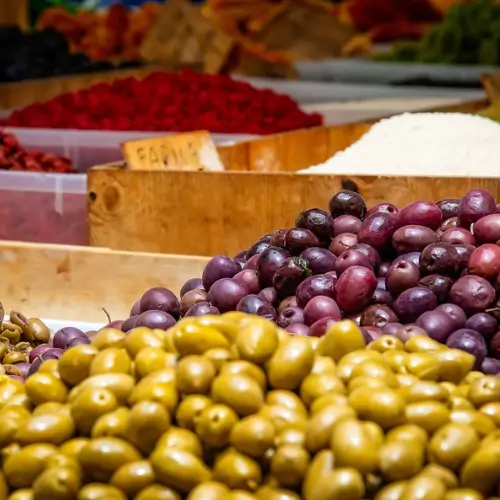
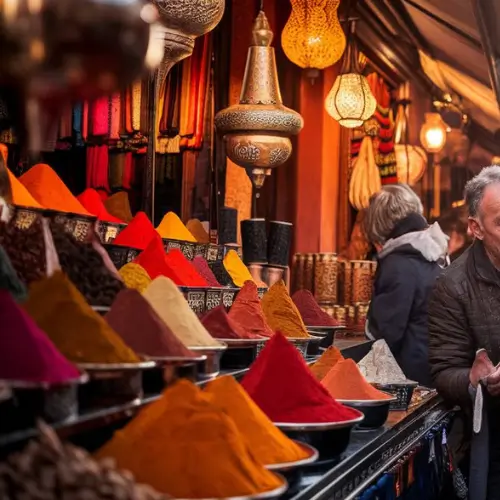
While commerce drives the souks, the experience extends beyond purchases. Consider these enriching activities:
- Food Exploration: Sample freshly squeezed orange juice, dried fruits, and nuts from reputable stalls with high turnover
- Artisan Workshops: Arrange visits to watch craftspeople practice traditional techniques—many welcome observers
- Hidden Foundouks: Explore these historic merchant inns converted into artisan workshops, often centered around peaceful courtyards
- Rooftop Views: Several cafés offer terrace seating with panoramic views over the marketplace
After shopping, return to Djemaa el-Fna as evening falls to witness its transformation into a vibrant night market filled with storytellers, musicians, and food stalls.
Shop Smart, Shop Kind: Responsible Souk Shopping
As visitors, we influence which traditions thrive and which fade. Consider these principles when shopping the Marrakech souks:
- Support True Artisans: Seek workshops where items are actually made rather than imported replicas
- Fair Bargaining: Haggle for fair prices, not exploitative ones remember that exceptionally low prices often indicate poor working conditions
- Ask Questions: Politely inquire about materials and production methods
- Sustainable Choices: Avoid endangered materials like cedar and certain animal products
- Quality Over Quantity: Invest in fewer, better pieces that support traditional craftsmanship
Frequently Asked Questions
How much should I bargain in Marrakech souks?
Expect to pay about 50-60% of the initial asking price for most items. Bargaining is expected, but remember that fair deals benefit both parties. Smaller purchases warrant less intensive negotiation.
Are Marrakech souks safe at night?
Main pathways remain quite safe through early evening (until around 9:00 PM) when many shops are still open. The atmosphere becomes more magical with lanterns illuminated, though fewer open shops means less natural surveillance in deeper souk areas.
What is the best day to visit the souks in Marrakech?
Weekdays (Monday through Thursday) typically offer a more relaxed shopping experience with fewer tourists. Avoid shopping immediately after Friday prayers when many shops remain closed.
Can you use credit cards in the Marrakech souks?
Mostly cash is required, though some larger establishments along main thoroughfares and in Souk Cherifia accept major credit cards (typically with a 3-5% surcharge). Always carry sufficient cash for most purchases.
Your Marrakech Souk Shopping Checklist
Before diving into the souks, ensure you’re prepared:
- [ ] Comfortable shoes for walking on uneven surfaces
- [ ] Small denominations of dirhams for easier transactions
- [ ] Reusable shopping bag for smaller purchases
- [ ] Water bottle to stay hydrated
- [ ] Hat and sunscreen for uncovered sections
- [ ] Basic Arabic phrases written down
- [ ] Business card from your accommodation for directions
- [ ] Camera with extra battery
- [ ] List of items you’re specifically seeking
- [ ] Price research on major items of interest
Embrace the Magic
The souks of Marrakech offer far more than merchandise—they provide a window into Morocco’s living cultural heritage. Behind each handcrafted item lies generations of expertise, cultural symbolism, and artistic tradition. Beyond the treasures you’ll bring home, the true value lies in the connections made, skills appreciated, and memories created while navigating this extraordinary marketplace.
Whether you’re hunting for that perfect leather pouch, distinctive ceramic tagine, or simply soaking in the atmosphere, approach your souk adventure with patience, respect, and curiosity. The momentary disorientation, animated bargaining, and sensory overload are all essential ingredients in what makes shopping in the Marrakech souks such an unforgettable experience.
What souk discoveries are you most excited to make on your Marrakech adventure? Share your own tips or questions in the comments below!





